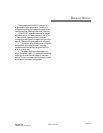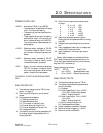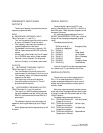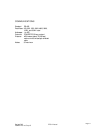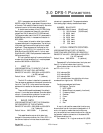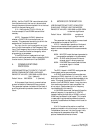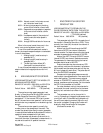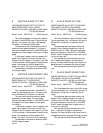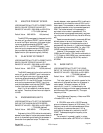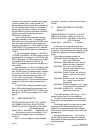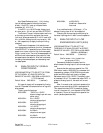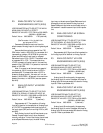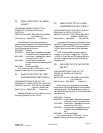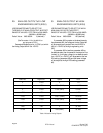Page 21
Revised 7/95 DFS-1 Manual
POWERTEC Ind. Corp.©
0000h Normal current limits (motor current
not limited at a lower level)
0001h Motoring torque setpoint (motoring
current to be limited at a lower level)
0002h Regenerative torque setpoint (regenera-
tive current to be limited at a lower
level)
0003h Horsepower setpoint (the product of
motor current and motor speed is
limited)
0004h through 000Fh available for future use
When in the normal mode, the current in the
motor is not controlled below current limit.
If one of the modified operational modes is
chosen, the torque/horsepower setpoint is selectable
in one of three places:
1. Analog Input #1 (must be set up in
parameter #17)
2. Analog Input #2 (must be set up in
parameter #21)
3. The Set Application Mode (8F)
Command via communications
If one of these three setpoints is not present, the
setpoint defaults to the appropriate current limit
level.
6. MAXIMUM MOTOR SPEED
USE PARAMETER #6 TO SET THE ABSOLUTE
MAXIMUM MOTOR SPEED.
RANGE OF VALUES: 0000 0001h to 0000 2710h
1 TO 10,000 (decimal)
Default Value: 0000 06D6h 1750 (decimal)
The maximum motor speed parameter is set
directly in Revolutions Per Minute (RPM) once the
Encoder Pulses Per Revolution (PPR) is set in
parameter # 7. If the incorrect PPR is set in param-
eter #7, the maximum motor speed will not be correct
and the motor may overspeed or not be able to go fast
enough.
The maximum motor speed is normally the
number given on the nameplate of the motor. This
number may be set higher than the motor nameplate
in some situations because the Brushless DC motor is
capable of some overspeed with light loads.
This parameter may be set to a value which is
lower than the motor’s base speed in cases where it is
not desired to use the full speed of the motor.
7. ENCODER PULSES PER
REVOLUTION
USE PARAMETER #7 TO ESTABLISH THE
PULSE FEEDBACK RATE FROM THE MOTOR.
RANGE OF VALUES: 0000 0001h to 0000 4E20h
1 TO 20,000 (decimal)
Default Value: 0000 0078h 120 (decimal)
This parameter tells the DFS-1 the resolution of
the encoder in Pulses Per Revolution (PPR). This is
normally four times (4X) the rate of one channel of
the motor’s encoder.
Motors from the 42 frame through the 259T
frame have a 30 PPR, two channel, quadrature
internal encoder. For these motors using the internal
encoders the parameter should be set to 120 PPR.
Motors from 287TZ through 5010ATZ have an
internal 60 PPR, two channel, quadrature encoder.
The parameter for these motors using the internal
encoders should be set to 240 PPR.
External encoders may have almost any PPR
rate, and they must have two channels in quadrature
(the channels have the same pulse rate, but they are
90° out of phase with each other). The pulse rate will
be on the ENCODER nameplate.
Encoders with higher pulse rates are normally
used to obtain lower speeds and/or finer resolution of
motor shaft position. The most common external
encoder on POWERTEC motors is a 600 PPR, two
channel, quadrature optical encoder. For this encoder
the PPR in this parameter will be 2400.
For other encoders, multiply the pulse rate for
one channel (the usual number given on the name-
plate) by four and enter that number in this param-
eter.
This parameter may not be changed while
running. Attempting to change this parameter while
running will result in the effect being delayed until
the next time a setpoint command is given or until
the control is stopped. Changing this number will
drastically affect the calibration of the system.
(Also see Parameter 46)



